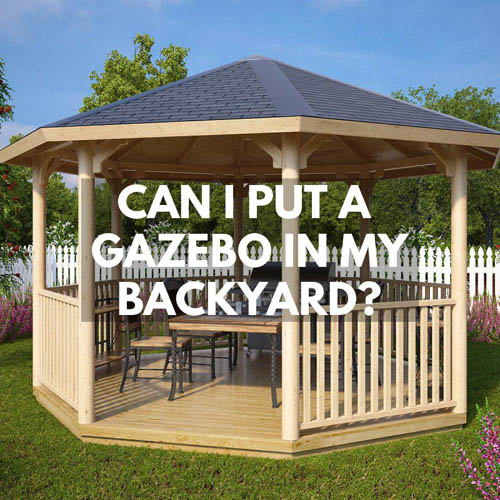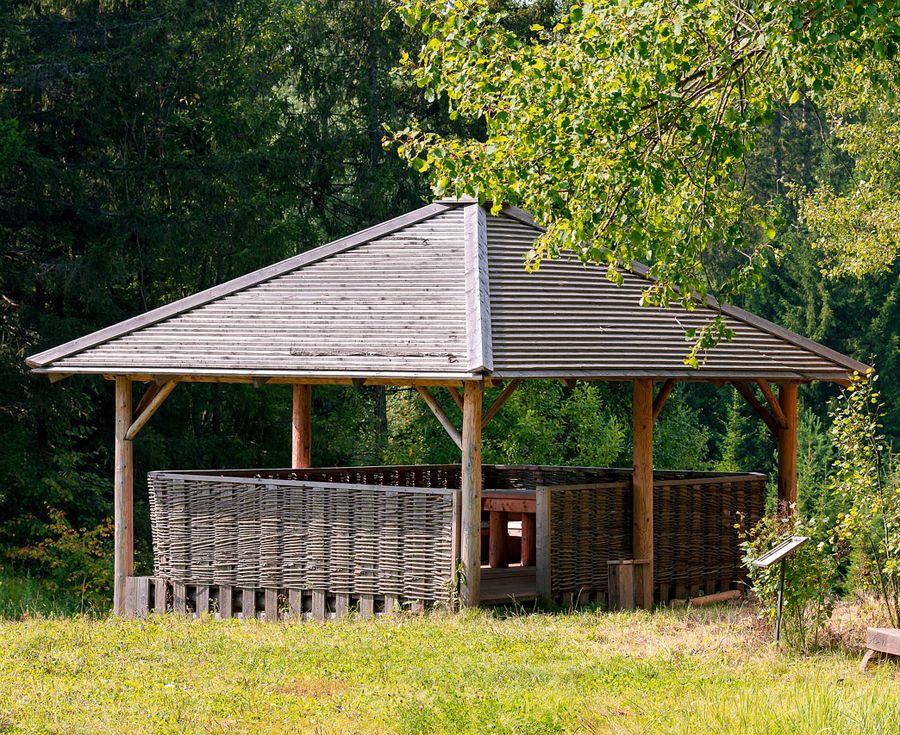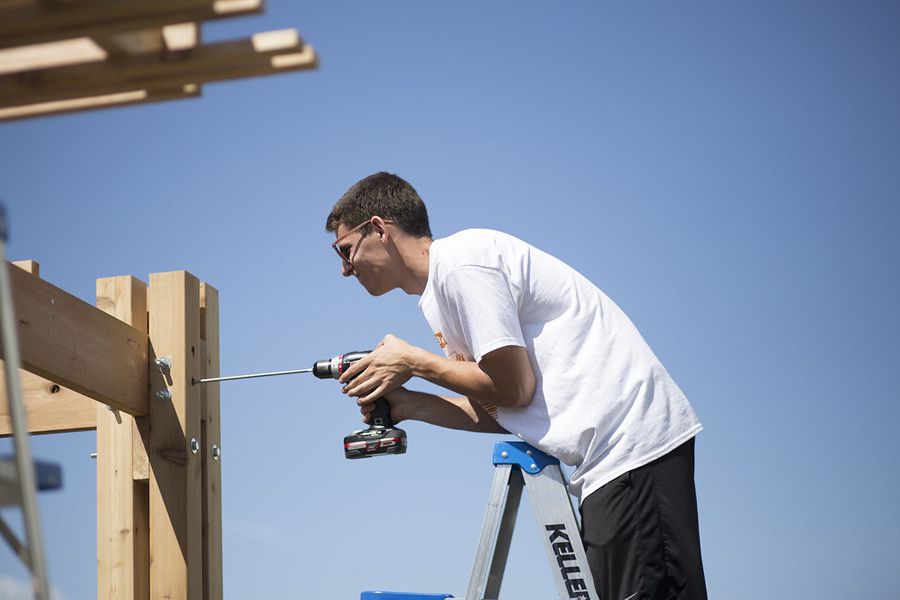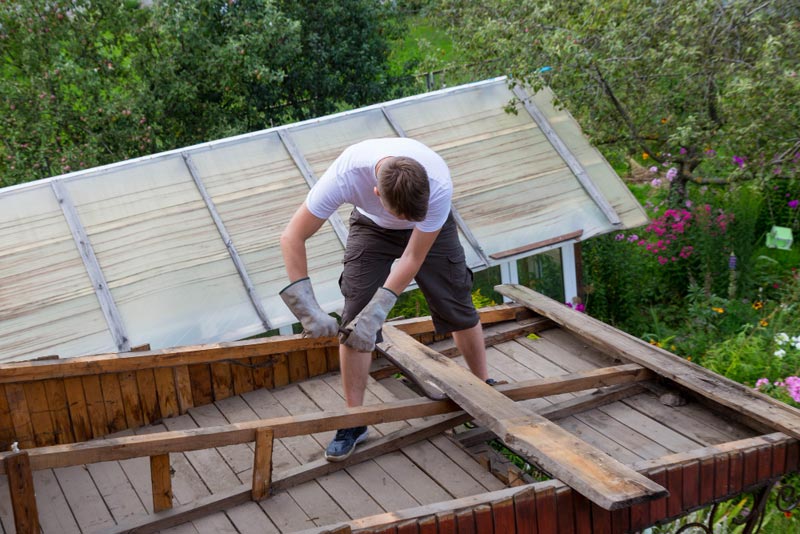
Can I put a gazebo in my backyard? In this article, we look at the things that might stop you from putting up a gazebo in your backyard as well as some considerations you must make when deciding.
Can I Put a Gazebo in My Backyard?
Installing a gazebo in your backyard is an easy way to enhance your outdoor living experience. Gazebos not only provide a beautiful focal point in your backyard but also offer a comfortable, shaded area to relax and entertain guests. However, there are some factors to consider before taking the plunge and adding a gazebo to your property.
One of the primary factors to consider is the requirement for permits, which may vary depending on where you live in the US. You may need up to four permits based on location, and intended usage, such as planning, building, running water, and electricity. It’s essential to check with your local planning department and HOA before starting to build your gazebo.
Additionally, it’s crucial to think about the placement and anchoring, as wooden gazebos need a stable foundation, whether it’s on grass or concrete, and must be anchored securely to prevent them from being blown away by strong winds.
Assessing Your Backyard Space
Before putting a gazebo in your backyard, it is essential to evaluate how much workable space you have and ensure that it meets specific prerequisites. Consider the following key factors to determine if your backyard is suitable for a gazebo:
Ground Stability
It’s vital to ensure that your backyard has a stable and level surface for the gazebo to be installed. This is to maintain the structural integrity of the gazebo and prevent any potential hazards. If you plan to place a gazebo without a floor, it may be necessary to prepare a concrete foundation. According to Country Lane Gazebos, gazebos should typically be placed on a concrete foundation or an existing concrete slab, ensuring proper drainage for the structure.
Size and Layout
Consider the size of your backyard and the gazebo dimensions to ensure there is enough space for installation and functionality. Keep in mind local regulations that may impose size restrictions on structures built on your property. Some local councils and townships have requirements for the size and placement of gazebos.
Avoid overcrowding your yard by selecting a gazebo size that complements the available space. Backyard Savvy suggests positioning a gazebo in a corner or against a wall if you have a small backyard in order to optimize the limited space.
Sunlight and Shade
When installing a gazebo, it’s essential to consider the amount of sunlight and shade your backyard receives. Select a location that balances natural light with shade, so you can enjoy your gazebo for longer every day. The ideal position of your gazebo should also take into consideration the potential impact on any nearby plants, which may rely on sunlight for growth.
back to menu ↑Legal Considerations

This is not legal advice, but having worked in the landscaping business for 6 years, I learned a few things as well as did a tonne of research for this article.
Permits and Zoning
When planning to build a gazebo in your backyard, it is essential to understand the permit requirements and zoning regulations in your area. Not all permit requirements are the same, and the necessary qualifications for gazebos can vary greatly depending on your location and specific factors.
In some areas, you may need up to four permits based on factors like size, utility connections, and building materials. Therefore, checking with your local zoning office and confirming the requirements before proceeding with construction is crucial.
Zoning regulations may also dictate the placement, size, or height of the gazebo. For example, some areas may require a minimum distance from property lines or restrict the height of structures. Make sure to verify these regulations to avoid potential legal issues later on.
Homeowners Association Requirements
If your property is part of a Homeowners Association (HOA), you may also have to adhere to their specific rules and guidelines regarding gazebos. HOA regulations often involve design, size, and color restrictions to maintain a consistent aesthetic within the neighborhood. Violating these rules can result in fines or even orders to dismantle the gazebo, so it’s crucial to review your community’s HOA guidelines in advance.
Before installing a gazebo, it is advisable to submit your plans to the HOA for approval. This can help you avoid potential disagreements and legal difficulties down the line. Ensure you provide all required documentation, such as drawings, material samples, and permits, if necessary, to expedite the approval process.
back to menu ↑Selecting the Right Gazebo

When deciding to add a gazebo to your backyard, selecting the right one for your needs and preferences is crucial. In this section, we’ll discuss key factors to consider when choosing the perfect gazebo, including material options, styles, and sizes.
Material Options
There are a variety of materials you can choose from when purchasing a gazebo. Some popular options include wood, metal, and vinyl. Wood gazebos are often chosen for their natural, warm appearance and can be made from various types, such as cedar, redwood, or pine. However, they may require more maintenance than other materials.
Metal gazebos, typically made from aluminum or steel, offer a more modern, sleek appearance and are often more durable and weather-resistant than wood. Vinyl gazebos, on the other hand, provide a low-maintenance option with a clean, polished look. Be sure to consider your budget, climate, and desired level of upkeep when selecting the gazebo material for your backyard.
Styles and Sizes
There is a wide array of gazebo styles and sizes to suit your backyard’s aesthetic and function. Some common styles include traditional, Victorian, and modern. Traditional gazebos often have a classic octagonal shape and ornamentation, while Victorian gazebos may feature elaborate detailing and curved railings. Modern gazebos focus on simplicity, with clean lines and minimal embellishment.
To determine an appropriate size for your gazebo, consider how you plan to use it and the available space in your backyard. According to Backyard Discovery, it’s vital to take into account factors like seating capacity, furniture placement, and space for walkways. Gazebos can range anywhere from 8×8 feet for a small, intimate space to 20×20 feet or larger for accommodating bigger gatherings.
When selecting the right gazebo for your backyard, be mindful of any local rules and regulations that may impact your choice. Check with your city or local homeowners association for any specific guidelines or permits that may be required during installation.
back to menu ↑Installation Process

Installing a gazebo is pretty simple, but it isn’t easy. It helps to do it with someone who knows what they are doing, but there is nothing stopping you from watching a bunch of youtube videos and having a crack at it yourself. That’s how I learn new skills these days.
Preparing the Site
Before installing a gazebo in your backyard, it’s essential to prepare the site where it will be placed. This can involve leveling the ground, removing any debris or obstacles, and marking out the location of the gazebo’s base.
If you’re planning on setting up the gazebo on grass, concrete, or pavers, follow the instructions provided by the manufacturer for the specific type of surface. Generally, you will need to mark out the location of the gazebo’s base, drill holes, and secure the gazebo structure using appropriate hardware.
Additionally, check with your local planning department and homeowners association (HOA) to determine if any permits are required for your gazebo installation.
Professional vs. DIY Installation
Installing a gazebo can be done by yourself, with a few friends, or by hiring a professional installation service.
DIY installation has the advantage of being more cost-effective but requires more effort, time, and tools. It is essential to read the gazebo’s assembly manual carefully and follow the instructions provided. For safety reasons, always have at least one helper during the installation process to prevent injuries. The benefit of doing it yourself is you will learn many new skills which will serve you for the rest of your life.
Professional installation services, such as those offered by The Home Depot, can be an excellent option for those who prefer not to do it themselves. These services are experienced in mounting various styles of gazebos, including wooden, metal, soft tops, pergolas, and canopies. The convenience of hiring professionals comes at a higher cost but ensures the structure will be assembled correctly and safely.
back to menu ↑Maintenance and Safety

Once you have built your gazebo, you then have to maintain it. In all honesty, this doesn’t take long and doesn’t need to be done very often. Simply clean any debris from the roof when needed and recoat the timber with a paint treatment every couple of years.
Routine Care
Regular upkeep is essential to keep your gazebo in good condition, ensuring its longevity and safety. Start by cleaning the gazebo periodically with water from a garden hose, especially for vinyl gazebos. If you have a metal gazebo, apply a rust sealant once or twice a year, as it can be left up year-round.
Keep grass, shrubbery, and other vegetation trimmed around the entire perimeter of the gazebo to prevent excess moisture and potential damage. Annually inspect for any signs of wear, rot, or damage, and repair or replace as necessary.
Weather-Related Concerns
Be proactive regarding weather-related concerns when installing and maintaining your gazebo in your backyard. Ensure a proper foundation to avoid issues related to water drainage and secure the structure to withstand strong wind gusts.
Some areas in America face heavy snowfall, so it’s crucial to regularly remove snow from the roof to prevent damage from excessive weight. Additionally, in regions prone to hurricanes or tornadoes, consider installing wind-resistant features such as hurricane straps or reinforced joints.
Always check your local building codes and regulations, as permit requirements may vary depending on your location. Following these guidelines will help keep your gazebo safe and well-maintained for years to come.
Now, if you hear anyone say, can I put a gazebo in my backyard? You will know what to say.







